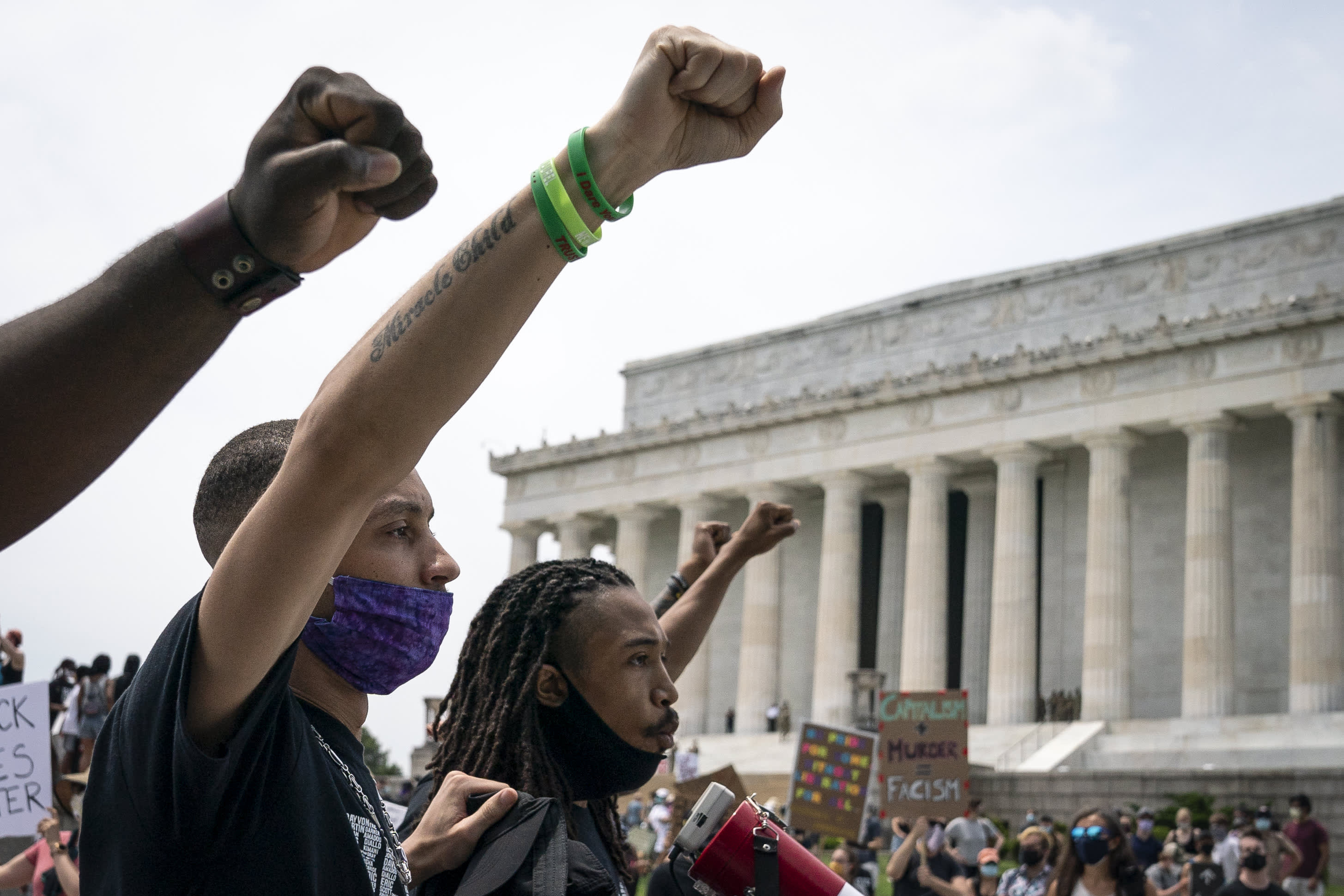Demonstrators march past the Lincoln Memorial during a protest against police brutality and racism takes place on June 6, 2020 in Washington, DC.
Drew Angerer
Companies have expressed support for the Black Lives Matter movement in recent weeks. But many advocates say now is the time for action — in the form of pay equity for nonwhite workers.
“It’s important that individual employers have a reckoning as it relates to pay and equality by race, ethnicity and gender, but it’s going to require broader and more systemic changes to really bring it down,” said Valerie Wilson, director of the Economic Policy Institute’s Program on Race, Ethnicity, and the Economy.
However, all too often after the protests end, nothing actually happens.
“We’ve seen unrest; we’ve seen people who are angry and rising up and saying it’s a problem,” said Maria P. Vallejo, partner at Chasan Lamparello Mallon & Cappuzzo in Secaucus, New Jersey.
“But after all the protests, the statements, people lay back down again and business resumes,” she said.
Over the last two weeks since George Floyd’s death in police custody, protests against systemic racism and excessive force have sprung up across the country, spanning from Los Angeles to New York to even small towns like Loganville, Georgia.
The outcry against violence has spurred Congress into action, as Democrats in the House and Senate have proposed a police reform bill.
Corporations, including General Motors and Ford, have also spoken up since Floyd’s death. In a letter to GM employees, Chair and CEO Mary Barra said the automaker will “commit to inclusion,” “unequivocally condemn intolerance” and “stand up against injustice.”
But firms will have to do more than speak up on these issues, financial and academic advocates say. They must follow through by addressing pay inequity in the workplace.
Consider that regardless of education, white workers out-earn their black colleagues.
Among workers with advanced degrees, the average hourly wage for whites was $44.46, compared with $36.23 for African Americans, according to the Economic Policy Institute.
There is also a persistent racial wealth gap. In 2016, the net worth of a typical white family was $171,000 in 2016, compared with $17,150 for a black family, the Brookings Institution found.
Even among high-income families, the difference persists. Among those in the top 10% for income, the median net worth for white families is nearly $1.8 million, versus $343,160 for African Americans, Brookings found.
“There is some acknowledgement that the same root cause behind incidents of brutality and violence against black people is the same root cause behind the persistent racial disparities we’ve seen in this country for centuries,” Wilson said. “And that is racism.”
Changes that matter
Diversity initiatives fall flat when companies fail to go beyond hiring people of color to entry-level positions.
“Statements are performative, but we want this work to go deeply,” said Rachel Robasciotti, principal at Robasciotti & Philipson, a San Francisco investment advisory firm that specializes in social justice investing.
“It’s not just about diverse hires,” she said. “You want to keep them. The way to do that is to do your internal work as an organization.”
Inclusion, in the context of diversity, means that these workers feel like they’re a part of the team — that they have a path toward advancement and mentorship to help them ascend into leadership posts.
“I want to see more women, more minorities, more people of color in the boardroom,” said Ayesha Hamilton, an employment attorney in Princeton, New Jersey. “I want to see them in leadership roles. This is how you build back the trust.”
Tackling the issue of pay equity, however, is a whole other herculean feat.
While laws like the Equal Pay Act and Title VII of the Civil Rights Act forbid discrimination based on gender and race, employees can have a hard time proving that they’re being offered fewer opportunities at work.
“Most individual workers don’t have the information they need to prove the case or the resources that it takes to file a claim against the employer,” Wilson said. “There are also issues of retaliation — you might be stigmatized as a troublemaker.”
In short, you won’t know you’re being underpaid unless you ask your peers how much they’re making — a topic that’s still taboo.
“Employees used to be prohibited from talking about their salaries,” Hamilton said. “We still have a cultural hurdle to overcome of employees distrusting their employers and feeling nervous about speaking to each other about salaries.”
Beyond good intentions
mihailomilovanovic
In order for employers to create a level playing field in the workplace, it’ll take a combination of good corporate policy and effective legislation.
Consider that last fall the U.S. Equal Employment Opportunity Commission shelved an Obama-era rule that called on employers to report pay data, broken down by race and gender.
“That law was one step in the direction of creating greater transparency to empower and strengthen workers to advocate for their rights,” Wilson said.
Employers can also have clearly defined jobs and pay ladders so that employees understand the requirements in their role, as well as the pay. Unions have worked to raise those issues, Wilson said.
“You have less information available to you versus the employer, and that makes it difficult to know where you stand relative to other workers, and the decisions made behind promotions and hiring,” she said.
So could we see an overhaul in the workplace that could finally close the racial wage gap? It could depend on whether Congress is ready to push for it.
“What happens after everything dies down? Does corporate conscience change?” Hamilton asked. “I don’t think it does. Not without accountability.”
